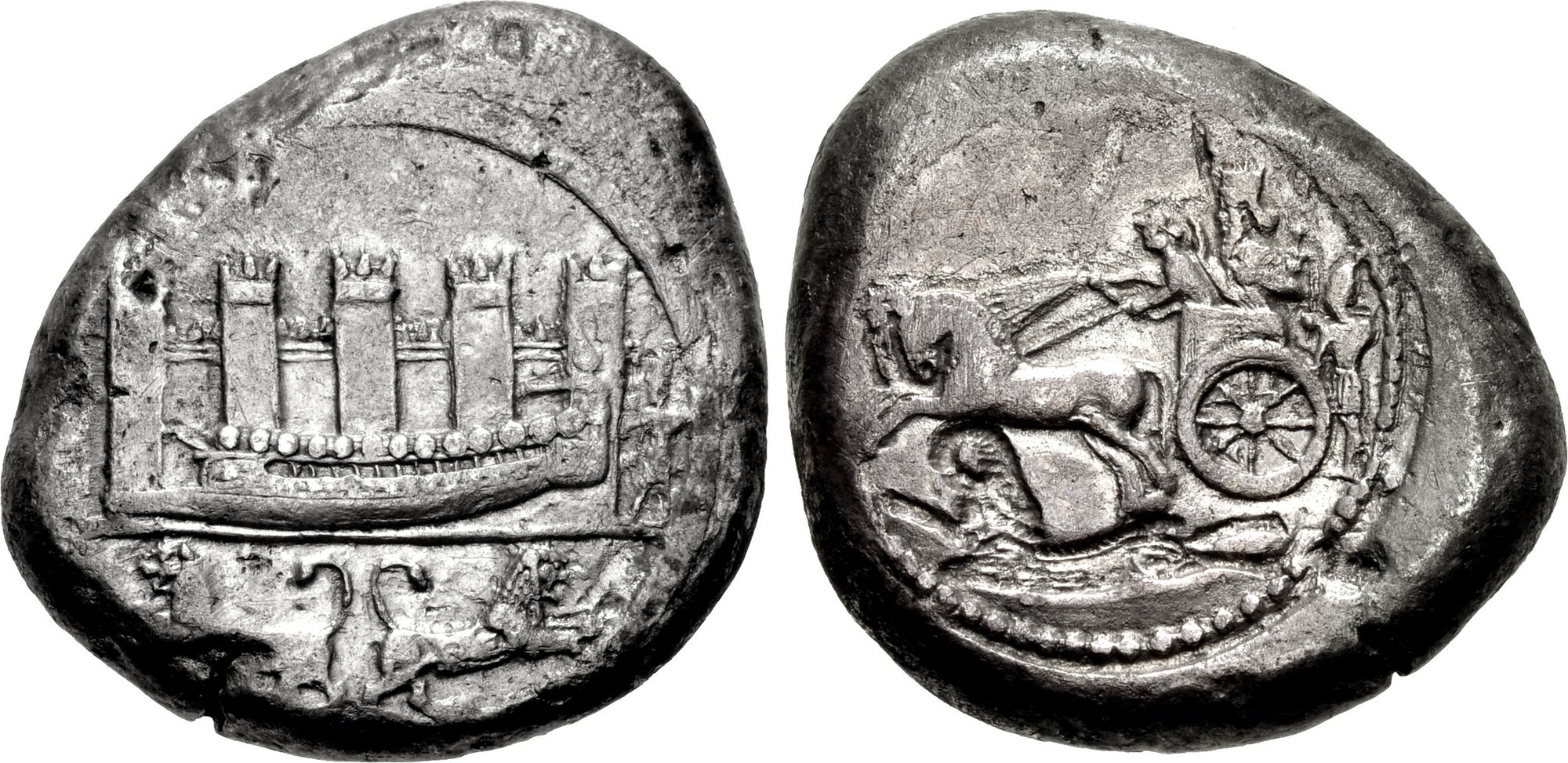Sidon (uncertain king), silver, double shekels (425-402 BCE)
From SILVER
425 BCE - 402 BCE Silver 21,532 kg
Description
| ObverseInscription or printing placed on the obverse.: | Phoenician galley left before city wall with five towers, two lions standing outward in exergue |
| ReverseInscription or printing placed on the reverse.: | King of Persia and driver in chariot drawn by two horses galloping left, behind, attendant standing left, below, incuse goat running left, all within dotted circle within incuse circle |
Mint and issuing power
| MintIdentifies the place of manufacture or issue of a numismatic object.: | Sidon | Ancient regionAncient region.: | Phoenicia | Modern countryModern country: Lebanon | AuthorityIdentifies the issuing power. The authority can be "pretended" when the name or the portrait of X is on the coin but he/she was not the issuing power. It can also be "uncertain" when there is no mention of X on the coin but he/she was the issuing power according to the historical sources: | Persian Empire |
Chronology
| FromIdentifies the initial date in a range assigned in a numismatic context. | 425 BCE | toIdentifies the final date in a range assigned in a numismatic context.. | 402 BCE | PeriodTime period of the numismatic object.: Classical 480-323 BC |
Physical description
| MetalThe physical material (usually metal) from which an object is made.: | Silver |
Median weightMedian of the weights of numismatic objects (in grams). in grams | 28.00 | DenominationTerm indicating the value of a numismatic object. Examples: tetradrachm, chalkous, denarius.: | double shekel | StandardStandard.: | Persian |
Image

S1884 Sidon double shekel III.1.jpg [1]
References
| Die study referencePublication of the study: | Elayi - Elayi 20041Elayi - Elayi 2004, p. 54-68, n° 194-274 (Group III.1) | ||
| Coin series referenceReference to coin series study: | Sear II2Sear II, n° 5930, HGC 103HGC 10, n° 221 | ||
| Coin series web referenceCoin series web references: | |||
Obverse dies distribution
| FrequencyFrequency of specimen in distribution. ᵖ | Number of obversesNumber of obverse dies. ᵖ (o) | % (o) | Number of coinsNumber of coins. (n) | % (n) | Die nameName(s) of the die(s). |
| 1 | 8 | 30.77 | 8 | 13.56 | 1, 6, 15, 18, 19, 24, 25, 26 |
| 2 | 10 | 38.46 | 20 | 33.9 | 2, 3, 7, 9, 10, 12, 16, 17, 20, 23 |
| 3 | 4 | 15.38 | 12 | 20.34 | 8, 11, 14, 21 |
| 4 | 2 | 7.69 | 8 | 13.56 | 5, 22 |
| 5 | 1 | 3.85 | 5 | 8.47 | 13 |
| 6 | 1 | 3.85 | 6 | 10.17 | 4 |
| Total | 26 of 26 | 100 | 59 of 59 | 100 |
Reverse dies distribution
no distribution is available
Quantification
| Number of obversesNumber of obverse dies. ᵖ (o) | 26 | Number of singletons (o1)The number of singleton coins. ᵖ | 8 |
| Number of reverse diesNumber of reverse dies. (r) | 41 | Number of coinsNumber of coins. (n) | 59 |
| Coins per obverse dieNumber of coins per obverse die. (n/o) | 2.27 | Coins per reverse dieNumber of coins per reverse die. (n/r) | 1.44 |
| Reverse per obverse ratioRatio of obverse dies divided by reverse dies. (r/o) | 1.58 | Percentage of singletons (o1)number of coins (n) divided by the number of singletons (o1) ᵖ | 30.77 % |
| Original number of dies (O) (Carter 1983 formula)The estimation of the number of coins according to Carter 1983 ᵖ | 38.45 | Coins struck if 20,000 as average productivity per dieCoins made if the average productivity for obverses (according to Carter) is 20,000. ᵖ | 769,000 |
| Original number of dies (O) (Esty 2011 formula)The estimation of the number of coins according to the singleton formula in Esty 2011 ᵖ (O) | 46.48 | Survival rate if 20,000 as average productivity per dieSurvival rate if average productivity is 20,000. ᵖ | 0.00008 |
| Coverage (o = % of O) (Esty 1984 formula)Esty 1984 - coverage (% of O) ᵖ (o = % of O) | 86.44% | Die productivity if survival rate 1/2,000Average productivity if survival rate is 1/2,000. ᵖ | 3,068.92 |
| Weight of silver (in kg) if 20,000 coins per die (O = Carter formula)Carter 1983 * Median weight * 20000 (*10 if gold or electrum) ᵖ | 21,532 kg <br /> 21,532 kg | Die productivity if survival rate 1/5,000Average productivity if survival rate is 1/5,000. ᵖ | 7,672.3 |
Remarks